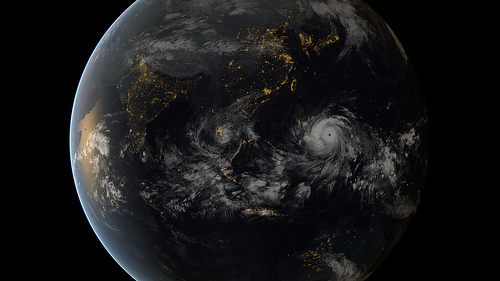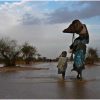
Author and Page information
- This page: https://www.globalissues.org/article/803/cop19-warsaw-climate-conference.
- To print all information (e.g. expanded side notes, shows alternative links), use the print version:
On this page:
Introduction
November 11 – 23, 2013, Warsaw, Poland was the venue for the 19th annual United Nations Climate Change Conference, also known as the 19th Conference of the Parties — or COP 19.
The purpose of this conference was to create a loss and damage pillar of a new climate treaty to be finalized in 2015. The other two pillars discussed in previous meetings are mitigation (emission reductions) and adaptation pillars.
Meeting outcome
The main outcome of the meeting was the establishment of an international mechanism for a loss and damage associated with climate change impacts .
Predictably, the loss and damage aspect of climate negotiations brought out the worst in some countries. Some developing countries were going to resist the idea of financing adaptation to climate change, while others appeared to hate the idea of climate reparations for poor countries. A few years earlier, industrialized nations had made a legal commitment to a global climate fund. Unsurprisingly, not much came of it, as Inter Press Service summarized,
In 2009 at the semi-infamous Copenhagen talks, the rich countries made a deal with developing countries, saying in effect:
We’ll give you billions of dollars for adaptation, ramping up to 100 billion dollars a year by 2020, in exchange for our mitigation amounting to small CO2 cuts instead of making the big cuts that we should do.The money to help poor countries adapt flowed for the first three years but has largely dried up. Warsaw was supposed to be the
Finance COPto bring the promised money. That didn’t happen.Countries like Germany, Switzerland and others in Europe only managed to scrape together promises of 110 million dollars into the Green Climate Fund. Developing countries wanted a guarantee of 70 billion a year by 2016 but were blocked by the U.S., Canada, Australia, Japan and others.
It got to the point that hundreds of representatives from various NGOs walked out of the negotiating rooms to protest against developed countries’ reluctance to commit to a loss and damage mechanism. And this was a day after the G77+China group of 133 developing countries walked out of negotiations over the same thing.
Looking through the briefing reports from the respected NGO, the Third World Network, It seems that on the surface, while an outcome was eventually thrashed out, there are many areas of weakness of sufficient vagueness to satisfy everyone that contentious issues that are seemingly resolved can still be challenged and changed in the future.
In context: common but differentiated responsibilities
Many years ago all nations agreed that climate change was largely the result of actions from today’s industrialized nations, as carbon dioxide — the main greenhouse gas — stays in the atmosphere for decades. Yet, the poorest would end up suffering the most for a problem they largely did not cause. The approaches to mitigation (emissions reduction) would therefore be different for those groups of countries — the common but differentiated responsibilities principle.
It is in this context that the discussion for loss and damage has come about. And it is something that rich countries are keen to get rid of .
The years of resistance on this issue (and many others) means each time it is discussed again the reactions seem to get even more hostile. Combined with the lack of detailed context in the mainstream media coverage of this aspect, it then becomes easier each time to see culprits as China and India given their enormous greenhouse emissions in recent years, compared to the far greater amount by the industrialized nations over the longer period. See this site’s section on climate justice for more detailed background.
In context: Typhoon Haiyan

The meeting came at the time when the devastating Typhoon Haiyan had just killed thousands in the Philippines and affected millions more. It was an ominous warning of what could be more frequent as climate change continues to take hold.
It was also an example of how poorer nations could be affected by a problem they have largely not been responsible for and that while all the international outpouring of aid and assistance was incredibly welcome, that support for preventing and adapting to such events is paramount and efforts are urgently needed to curb emission increases.
In an emotional speech the Philippines lead negotiator for the conference, Naderev Saño, received a standing ovation for announcing that he will go on a hunger strike until a meaningful outcome is in sight.
Lack of urgency
Inter Press Service (IPS) noted the seeming lack of urgency given the years and years of delay and watering down of meaningful action:
To have a good chance at staying under two degrees C, industrialised countries need to crash their CO2 emissions 10 percent per year starting in 2014, said Kevin Anderson of the Tyndall Centre for Climate Change Research at the University of Manchester.
We can still do two C but not the way we’re going,Anderson said on the sidelines of COP 19 in Warsaw. He wondered why negotiators on the inside are not reacting to the reality that it is too late for incremental changes.
I’m really stunned there is no sense of urgency here,he told IPS.
More information
As the conference is still underway as this page is written, more information will be added here after the event is over.
For more about the issues from other organizations, here are some starting points:
News stories from IPS
Below is a list of stories from Inter Press Service related to the Warsaw climate conference and its aftermath.
-
Adapting to climate change ‘happening worldwide’, essential
– UN News

The impacts of climate change are already “very visible” and “happening worldwide”, the head of the UN weather agency told the start of the 55th Session of the UN’s Intergovernmental Panel on Climate Change (IPCC) which convened on Monday.
-
World must ‘change track’ to protect oceans from climate crisis: Guterres
– UN News

The planet is facing the triple crises of climate disruption, biodiversity loss and pollution, Secretary-General António Guterres told the One Ocean Summit on Friday, warning that “the ocean shoulders much of the burden”.
-
Wetlands: ‘Unsung heroes’ of the climate crisis
– UN News

For the first time, the United Nations on Wednesday celebrates World Wetlands Day, recognizing that these fragile ecosystems make a crucial contribution to biodiversity, climate mitigation, freshwater availability, and economic resilience.
-
2021 Year in Review: Climate action, or blah, blah, blah?
– UN News

This year saw another steady stream of UN-backed reports reinforcing a stark message: man-made climate change is an urgent and even existential threat to life on Earth. Will the international community’s efforts to tackle the crisis, as seen at the COP26 UN Climate Conference, result in meaningful action?
-
Uruguay Launches Sovereign Bond Linked to Climate Targets
– Inter Press Service

BUENOS AIRES, Dec 23 (IPS) – Sustainable finance continues to expand in Latin America, as governments and companies take advantage of growing interest among investors in instruments that protect biodiversity and respond to the climate crisis. In 2020, more than US$16 billion of green, social and sustainable bonds were issued in the region.
-
Blue Ocean Solutions for Climate Resilience and Accelerated Development
– Inter Press Service

Nairobi, Kenya, Dec 22 (IPS) – Seychelles’ 115 islands are an exotic ocean ecosystem of beaches, coral reefs, and unique plant and animal species. Concerned with the impacts of climate change, the country has committed to decarbonize by 2050.
-
Nature-based Solutions for enhancing coordinated action around climate change, land and biodiversity
– Inter Press Service

London, Dec 17 (IPS) – A key outcome of COP26 climate summit is the enhanced focus on “nature-based solutions” – the plans for people to work closely alongside nature to avert a planetary catastrophe.
-
UN rights forum’s action on climate and COVID-19 vaccines shows its relevance, says President
– UN News

After one of the busiest years in the history of the Human Rights Council, President Nashat Shameem Khan insisted on Thursday that the UN forum remains more relevant than ever, citing action on COVID-19 vaccine inequity, climate change and no less than five Special Sessions in Geneva.
-
Youth at Forefront of Climate Change Action Will Make Biggest Impact
– Inter Press Service

Nairobi, Kenya, Dec 15 (IPS) – On Gladys Habu’s birthday, she filmed a message to world leaders while standing waist-deep in the sea next to a dead tree stump – the only remnant of Kale Island now submerged underwater due to climate-change-induced sea-level rise.
-
Climate change ‘aggravating factor for terrorism’: UN chief
– UN News

Environmental degradation enables armed groups to extend their influence and manipulate resources to their advantage, the UN chief told the Security Council on Thursday, highlighting that conflict-prevention initiatives need to factor in climate risks.
-
Climate Change: Adapt for the Future, Not the Past
– Inter Press Service

SYDNEY and KUALA LUMPUR, Dec 07 (IPS) – Funding for developing countries to address global warming is grossly inadequate. Very little finance is for adaptation to climate change, the urgent need of countries most adversely affected. Also, adaptation needs to be forward-looking rather than only addressing accumulated problems.
-
From the Field: ‘climate-smart’ development in an uncertain world
– UN News

Today, when the UN plans initiatives to help vulnerable communities become more resilient, the climate crisis has to be part of the equation. The UN Development Programme (UNDP) is connecting the dots between people and the impacts that climate change is having on their lives.
-
COP26: Convert climate ‘promises to action’, urge UN rights experts
– UN News

Marking the 35th anniversary of the Declaration on the Right to Development, independent UN human rights experts on Friday issued an urgent call to “move from promises to action” on the outcomes of the UN’s landmark COP26 climate conference.
-
What Will it Take to Turn Farmers Toward Climate-Resilient Superfood Millet?
– Inter Press Service

Bulawayo, ZIMBABWE , Dec 1 2021 (IPS) – Millet could be Africa’s silver bullet for combating anaemia – and apart from health benefits, it is climate-resilient.
-
Climate Change with 8 Billion Humans
– Inter Press Service

PORTLAND, USA, Nov 23 (IPS) – With world population approaching 8 billion humans, the demographic growth of nations is unfortunately largely ignored by governments whenever climate change is considered.
-
Interview: The most impactful actions at COP26 point to progress on climate change
– UN News

Of the many agreements and initiatives announced at the 26th UN Climate Conference (COP26) in Glasgow, the UN Climate Communications Lead at the Department of Global Communications narrowed down the three that she deemed most impactful.
-
What Governments Should Learn from The Climate Activists
– Inter Press Service

Nov 15 (IPS) – Shantha Rau Barriga is the disability rights director and the lead on Strategy Development at Human Rights Watch“Nothing about us without us” – that was the call from the indigenous rights advocate Ghazali Ohorella from the Alifuru people in the Maluku Islands, Indonesia during a panel at the climate summit in Glasgow.
-
Glasgow Summit Ends Amidst Climate of Disappointment
– Inter Press Service

GLASGOW, Nov 14 (IPS) – Developing countries will surely remember the Glasgow climate summit, the most important since 2015, as a fiasco that left them as an afterthought.
-
COP26 closes with ‘compromise’ deal on climate, but it’s not enough, says UN chief
– UN News

After extending the COP26 climate negotiations an extra day, nearly 200 countries in Glasgow, Scotland, adopted on Saturday an outcome document that, according to the UN Secretary-General, reflects the interests, the contradictions, and the state of political will in the world today.
-
Climate action can deliver a sustainable future for all: UN deputy chief
– UN News

Climate action can be the driver for a green and equitable future for all, UN Deputy Secretary-General Amina Mohammed has said at the TED Countdown Summit, urging people everywhere to demand that leaders deliver on their promise to limit global warming.
-
As COP26 deadline slips, negotiators to keep working to agree crucial climate deal
– UN News

COP26, the UN climate summit in Glasgow, is running into overtime, as leaders and negotiators will keep working to reach a deal that could spare the world from catastrophic global warming.
-
Violence, insecurity and climate change drive 84 million people from their homes
– UN News

As more people flee violence, insecurity and the effects of climate change, the number forcibly displaced now exceeds 84 million globally, according to new data released on Thursday by the UN refugee agency, UNHCR.
-
COP26: Climate Action in Agribusiness Could Reduce Emissions by up to 7 per Cent
– Inter Press Service
-
UN chief welcomes China-US pledge to cooperate on climate action
– UN News

Wednesday’s announcement that China and the United States have agreed to collaborate more closely on climate action was hailed by UN Secretary-General António Guterres as an important step in the right direction.
-
Climate change increasing threats in southwest Pacific: WMO report
– UN News

From rising sea temperatures, to deadly and devastating storms and floods, climate change is increasing threats in the southwest Pacific, the World Meteorological Organization (WMO) said in a report published on Wednesday.
-
COP26: Avoiding Carbon Tunnel Vision: Action on Climate Change Needs an Inter-connected Response
– Inter Press Service

AMSTERDAM, the Netherlands, Nov 10 (IPS) – With the UN climate change conference – COP26 – continuing this week in Glasgow, it’s obvious that there is consensus among a majority of world leaders and key stakeholders that much more needs to be done, if the ambition of keeping global warming to a 1.5-degree increase is to have any chance of being met. Yet talk, as they say, is cheap. Or, in the words of Greta: too much “blah, blah, blah” and not enough action.
-
COP26 – Adapting to the Climate Crisis
– Inter Press Service

OTTAWA, Canada, Nov 09 (IPS) – Look up any map showing today’s global humanitarian crises and you’ll find it awash in red alerts more than ever before. Climate emergencies are fast emerging in new areas that have never previously witnessed them, and they are accelerating humanity’s march towards the precipice in regions long battered by conflict, hunger and displacement.
-
Magical Thinking on Fertilizer and Climate Change
– Inter Press Service

CAMBRIDGE, Nov 09 (IPS) – As world leaders wrap up the UN Climate Summit in Glasgow, new scientific research shows that there is still a great deal of magical thinking about the contribution of fertilizer to global warming.
-
COP26: Climate Justice Begins with the Human Right to Water
– Inter Press Service

GLASGOW, Scotland, Nov 09 (IPS) – As the UN Climate Change Conference (COP26) is swiftly moving to its conclusion on Friday, climate justice could not be more urgent or timely.
-
Women bear the brunt of the climate crisis, COP26 highlights
– UN News

Women took the global stage on Tuesday to show that climate change isn’t gender neutral, and that climate action needs them: investing in women and girls creates ripple effects felt throughout entire communities and the frontline knowledge they possess is needed now more than ever, especially as new analysis has revealed that the announcements by world leaders at COP26 still leave our planet on the path to catastrophic global warming.
Author and Page Information
- Created: